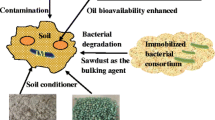Abstract
Partial bioremediation of polychlorinated biphenyl (PCB)-contaminated soil was achieved by repeated applications of PCB-degrading bacteria and a surfactant applied 34 times over an 18-week period. Two bacterial species, Arthrobacter sp. strain B1B and Ralstonia eutrophus H850, were induced for PCB degradation by carvone and salicylic acid, respectively, and were complementary for the removal of different PCB congeners. A variety of application strategies was examined utilizing a surfactant, sorbitan trioleate, which served both as a carbon substrate for the inoculum and as a detergent for the mobilization of PCBs. In soil containing 100 μg Aroclor 1242 g−1 soil, bioaugmentation resulted in 55–59% PCB removal after 34 applications. However, most PCB removal occurred within the first 9 weeks. In contrast, repeated addition of surfactant and carvone to non-inoculated soil resulted in 30–36% PCB removal by the indigenous soil bacteria. The results suggest that bioaugmentation with surfactant-grown, carvone-induced, PCB-degrading bacteria may provide an effective treatment for partial decontamination of PCB-contaminated soils.
Similar content being viewed by others
Author information
Authors and Affiliations
Additional information
Received: 9 March 2000 / Received revision: 27 June 2000 / Accepted: 16 July 2000
Rights and permissions
About this article
Cite this article
Singer, A., Gilbert, E., Luepromchai, E. et al. Bioremediation of polychlorinated biphenyl-contaminated soil using carvone and surfactant-grown bacteria. Appl Microbiol Biotechnol 54, 838–843 (2000). https://doi.org/10.1007/s002530000472
Issue Date:
DOI: https://doi.org/10.1007/s002530000472




